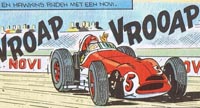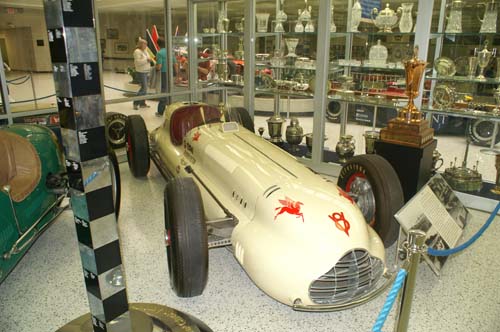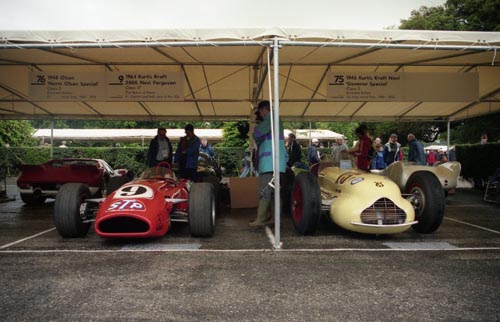Mercedosaurus Rex at Indianapolic Park
Part 8: The forerunner
Author
- Henri Greuter
Date
- September 22, 2009
Related articles
- March-Alfa Romeo 90CA - Fiasco Italo-Brittanico, by Henri Greuter
- March-Porsche 90P - The last oddball at the Indianapolis Motor Speedway, by Henri Greuter
- Penske-Mercedes PC23-500I - Mercedosaurus Rex at Indianapolic Park, by Henri Greuter
- Introduction
- Part 1: Penske Racing at Indianapolis - new standards
- Part 2: Ilmor Engineering at Indianapolis
- Part 3: Mercedes, Benz and Mercedes-Benz at Indianapolis up until 1993
- Part 4: Equivalency formulas - waiting for things to go wrong
- Part 5: Stock blocks - keeping them rolling and promoting 'Born in the USA' technology
- Part 6: Indianapolis 1991 - Chevy And Rich Team owners
- Part 7: The Speedway narrowed, its speeds lowered
- Part 9: Pre-May '94 plans
- Part 10: Penske PC23 - a home for the engine
- Part 11: The 1994 Indycar season until mid-April
- Part 12: The unfair advantage and when others have it
- Part 13: Practice during the 1994 'Month of May'
- Part 14: Other bespoke-design 209s
- Part 15: From the last weekend of May '94 to the end of the season
- Part 16: Could the Mercedes Benz 500I have been stopped in time?
- Part 17: Creating an extinct species without it being forbidden, initially at least
- Part 18: The 1995 '500' - Did the Mercedosaurus bite its masters after all?
- Part 19: A possible twist of fate for Rahal-Hogan and Penske as a legacy of the 500I
- Part 20: Re-evaluation of our verdict
- Part 21: PC23's further active career after 1994
- Part 22: USAC’s points of views and some answers
- Part 23: The loose ends that didn’t fit in anywhere else and the epilogue
- Part 24: "Plan your work; work your plan" - Chuck Sprague on the PC23
- Appendix 1: Specifications
- Appendix 2: Car and driver appearances and performances during the Month of May 1994
- Appendix 3: Chassis, entry, practice and race numbers in 1994
- Appendix 4: PC23's 1994 results sans Mercedes Benz 500I
- Appendix 5: PC23's 1995-'96 results sans Mercedes Benz 500I
- Appendix 6: A reflection on the PC23 chassis used by Team Penske in 1994
- Appendix 7: A review of Beast by Jade Gurss
Who?'Sam Hawkins' What?'Texas Driver's Club Novi' (inspired on 1963 Kurtis 500K-Novi) Where?Comic book Suspense en Indianapolis by Jean Graton When?'1964 Indianapolis 500 qualifying' |
 |
Why?
A car built with the intention of being unbeatable on the straights of Indianapolis Motor Speedway, being able to overtake anything at will anytime, once there. It's a concept that's been tried before. Die-hard Indianapolis veterans and fans will instantly say one single word to describe a car that was built for such a race strategy.
Novi.
To describe the entire Novi legend in an introduction to another car is an insult to the Novi. Like it is some kind of an insult for a fairly well thought-out concept such as the 1994 Penske car to be compared with a bunch of cars that were such dismal failures. But there were some similarities too.
The heart of the Novi legend was a quad-cam, 3-litre supercharged V8 engine, built by the Offenhauser Engineering company in 1941 and designed by Bud Winfield and Leo Goosen. The engine was commissioned by car owner Lew Welch. Still known in 1941 as the Winfield V8, its 450hp gave the engine a power advantage of at least 125hp on the majority of its opposition, the Offy-powered brigade. The Winfield was built into one of the ten front-wheel-driven 1935 Miller-Ford chassis.

Seen here in May 2016. The reworked 1935 Miller-Ford chassis that was fitted with the very first Winfield-Novi engine. The snailhouse in the back of the engine bay is the supercharger, on top of the engine the intercooler and the ducting for cool air towards the intercooler can be seen. The half-circle little tubes about halfway the engine are part of the left-side manifold pop-off. Not visible on this picture but the car still has a little left of the original 1941 paint-job. The engine is a genuine Winfield-Novi but due to loss of some of the one-off parts made in 1941, it does use some components of postwar origin. (photo HG)
Ralph Hepburn qualified the car but legend has it that he put a piece of wood under the accelerator to prevent him from ever using full throttle, The decently handling Miller chassis wasn’t built for such staggering amounts of power and the weight of the engine (260 kilo) upset the entire balance. Nevertheless, Hepburn brought his monster across the finish line and was classified 4th. The war ended further race participation for the Winfield V8 but it was back in action in 1946. By then it had the Novi name with which it became legendary. Due to rule changes in 1957, the Novi changed to 2.8-litre capacity. Between 1946 and 1960 Lew Welch entered cars with the engine that was exclusive to him, from 1946 to 1955 in newly designed and built front-wheel-drive cars, the latter five years in rear-wheel-driven 'roadsters'. All chassis were built by Frank Kurtis. Although they were entered under various names, everyone talked about the Novis, the engine effectively having given its name to the car. After Welch went bankrupt the cars and engines were taken over by the Granatelli brothers who kept the engines alive for another six years.
The most powerful opponent the Novi ever met in straight competition was about equal in performance. It was the time when Don Lee's team fielded a genuine pre-war 1939 Mercedes W154 GP car in 1947 and 1948. And then, in its final year at the Speedway, the Novi finally faced an opponent stronger than the legendary V8, if only in qualifying: the 1966 Demler turbine, reported to have had an output of some 1000hp.
Other than those two, there was no single year when the Novi failed to have at least 100hp over its opponents. More often its advantage was closer to 200hp. Despite being an oversquare engine, it provided tons of torque in addition to all its power. As long as the drivers managed to avoid excessive wheel spin, the Novi had a tremendous acceleration down the straights and superior top speeds.
Lew Welch scored a third place in 1948 (the car driven by Duke Nalon) and two fourth places in 1947 (Cliff Bergere and Herb Ardinger as co-drivers) and 1957 (with Paul Russo) as well as two pole positions (Duke Nalon in both 1949 and 1951). On no less than five occasions a Novi was the fastest qualifier in the field. Other than that, the Novi legend harbours two fatal practice accidents (Ralph Hepburn in 1948 and Chet Miller in 1953), a near fatal race accident (Duke Nalon in 1949) and a bunch of retirements due to mechanical failure as well as a number of DNQs due to the use of outdated (FWD) chassis and mechanical troubles. In their final years under Welch ownership the cars failed to qualify due to an unproperly carried out engine improvement. Before his bankruptcy in 1961, Lew Welch donated his remaining FWD Novi to the Speedway museum. Because of the tremendous popularity of especially the FWD Novis and their status at Indianapolis being so legendary, the car was - until fairly recently - one of a very small number cars on permanent display that didn't win the race.

One of the two front-wheel-drive Novis ever built is part of the IMS Museum's collection. This is the car last used in 1955 and restored back to 1948 trim as much as possible. Save a few details, this is how the car looked when Duke Nalon finished third in 1948. Here seen in May 2008. (photo HG)
The Granatellis didn't enter their cars with Novi being part of their names although the engine was still being called Novi by them. The cars actually wore decals telling they were Novi-powered. In general everyone kept talking about the cars as being Novis as well. The Granatellis failed to win any poles, but didn't suffer any fatalities either. Their best score ever was an 11th place (in 1964 with Art Malone). They stuck with front-engined cars that became obsolete as soon as the rear-engined cars took over. Advised by Stirling Moss, they tried 4WD in 1964 and 1965 in order to harnass the supercharged V8's stupendous power. The last-ever Novi ran in 1966. The Ford V8 had some 500hp, the supercharged and turbocharged Offenhausers could produce a reasonably reliable 525hp or a bit more. And yet the Novi failed to qualify despite 4WD and a reported 837hp!
During its entire career, the misfortunes that befell the Novi were legendary and the cars were said to be cursed by bad luck. So notoriously unlucky that the 'Novi Jinx' became part of Indy history. Bad luck was indeed a factor but it wasn't responsible for all the failures.
Sound as the theories behind the Novi appeared to be, the engine and cars were ill-conceived. It all started with the fact that despite some novelties in design and lay-out the V8 was a long, big, heavy piece of machinery, adding up heavily to the total weight of the cars it was fitted into.
Due to it being supercharged - and with boost levels that were stunning for the time - the engine required a methanol-based fuel blend. Since methanol gives poor fuel consumption, the cars needed big fuel tanks to avoid having to make too many time-consuming pit stops. But a large fuel capacity on board also added up to the weight of a race-ready car. In order to generate a surplus of power, a surplus of fuel was needed.
In the first decade of the Novis, owner Lew Welch was convinced about the superiority of front-wheel drive at Indianapolis. So he had cars on which the front wheels were responsible for transmitting the power onto the track as well as steering the car through the turns. Ironically for Welch, his opponent Lou Moore won three “500s” in a row with FWD cars resembling the Novis. Lou Moore’s Blue Crowns had about little over half the power of the Novis but were much lighter and much more fuel-efficient. These cars were capable of doing half a race on a single set of tyres, thus requiring only one pit stop for fuel and fresh rubber. When Lew Welch wanted his car to follow a similar strategy in 1948, the car got a 112 gallon/435 litre fuel tank! Nalon managed to drive 100 laps on his first tank of fuel but something went wrong during refuelling, forcing Nalon to make a splash-and-dash with 16 laps to go.
The tyres of the period were unable to cope with the power and weight at the speeds the Novis were capable of, be it on front or rear-wheel drive Novis. And so the Novis ended up in a vicious circle they couldn’t break. At all-out speed they wore out their fuel capacity and tyres in record time. This required pits stops that lost more time than was gained with their lap speeds. So they had to be driven even faster to make up for that lost time, at the expense of even more pit stops!
During the Welch years (1946-1960) the team paid little if any attention to developing a decently handling chassis. The search for power and more power never stopped. The Granatellis gave more attention to finding ways to control the power. One can argue whether they did the right things but at least they tried. Some of their efforts simply deserved better. In 1964 the promising 4WD car was wrecked in the tragedy that took the lives of Dave MacDonald and Eddie Sachs. And a brand new lightweight - to Novi standards, that was… - 4WD chassis was wrecked the day before Pole Day 1965 when driver Bobby Unser couldn't avoid running into another spinning car. Typical Novi luck…
The sheer weight of the engine alone was a disadvantage for any car to begin with. It lost some weight over the years but remained the heaviest engine used, other than in 1950 and 1952 when the even heavier Cummins diesels were used. Novis were always the heaviest cars save in 1952 when the Cummins Diesel weighed even more. The 1964 Shrike-Ford of Eddie Sachs weighed some 540kg, the 4WD 1964 Ferguson-Novi was told to weigh some 900kg but I have heard that a weight of about 1050kg (almost twice that of the Shrike!) was closer to the truth...
Had the engine been developed to produce its power as efficiently as possible, with chassis development taking place as well, the Novi concept could have been more successful. None of this however happened in time. Although the Novis were by far the most popular with the crowd, they were hardly the the near-invincible-but-jinxed cars they were believed to be.
If the concept of having an invincible car on the straights was able to be successful it had yet to be demonstrated properly. Following the path set out by the Novi could only be successful if it was done with a much better thought-out complete package.
There is however one thing the Novi achieved. During its entire career it was the most popular engine and car of its day. If your favourite driver didn't drive a Novi, you wouldn't mind him losing out to a Novi. The fan appeal of the Novi cars remained unrivalled by any other car in later years, maybe with the exception of the Coyote chassis driven by AJ Foyt. And unlike with the Novi, that was more because of the driver than the car.
Maybe the team owners of the Novi cars weren't among the most popular team owners, their drivers and their cars most certainly were. In the first ten post-war years that the Speedway was used again, the two FWD Novis participated in many of the best known and legendary events. It can be argued that the post-war popularity of the “500” was certainly enhanced by the ill-fated but beloved FWD Novis. The RWD roadsters and 4WD cars that followed inherited this popularity. One feature making the Novi V8 so popular and unique was its noise. It was the only engine ever at Indianapolis that was so loud that during a qualifying attempt you could hear the engine noise all of the time, allowing you to place the car on the track.
In the late 50s French comic book artist Jean Graton debuted his series of adventures about French racing driver Michel Vaillant. In the very first adventure The Great Challenge (nowadays available in English translation too) Graton included a '500' in Michel's schedule. Such was the fame, reputation and impact of the Novi that Graton opted to have Michel's primary opponent driving a Novi, inspired on the real 1957 cars. Graton needed an American-built F1 car in his second album and this imaginary car was named Novi Europ. So it isn't that strange that when Graton had Michel competing at Indianapolis again in a 1964 adventure he put up Michel against two Novis, this time the menacing 1963 versions (see top picture).
A total of about 12 Novi engines were built over the years, built into nine different chassis. At the time of writing (August 2009) it is known that one of these cars was cannibalized and trashed after being retired. The exact fates of two chassis aren't entirely sorted and confirmed. Four cars are part of museum collections although only one is in running condition. Two cars are in private hands, one of these in running condition. The other privately owned car has been in running condition yet was damaged recently. The damage is said to be repairable.
November 2013 update: One of the two Novi cars that was missing has shown up as part of a museum collection. That makes it five cars being part of museum collections. Now only a single car is still unaccounted for.

Seen next to each other at Goodwood’s Festival of Speed in 1998, the first and the next to last of the Novis. On the left is the 4WD Ferguson P104 built in 1964, restored to its 1965 configuration. This was the first-ever time since March 1964, when Ferguson shipped off the finished car to the USA, that 'Fergie' returned to England. Unlike the sign above the car, this was not a Kurtis Kraft: Ferguson built the chassis. On the right, making its first-ever public appearance since Chet Miller's fatal crash in 1953, the first Novi, built in 1946 and restored to its 1953 shape. Both these cars are in running condition but Goodwood 1998 was the first time ever that these two Novis were reunited, perhaps the first-ever reunion for two Novis in running condition. (photo HG)
